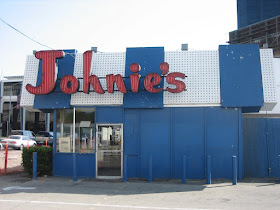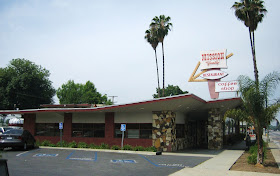 Bruce Goff's idiosyncratic buildings, often described as organic architecture, are characterized by expressive shapes, the use of unusual materials, and spatially complex interiors. Despite Goff's lack of formal architectural training, the University of Oklahoma appointed the self-taught architect as a professor and then as the chairman of their School of Architecture in 1943.
Bruce Goff's idiosyncratic buildings, often described as organic architecture, are characterized by expressive shapes, the use of unusual materials, and spatially complex interiors. Despite Goff's lack of formal architectural training, the University of Oklahoma appointed the self-taught architect as a professor and then as the chairman of their School of Architecture in 1943. The Pavilion's exterior walls are made of translucent fiberglass panels designed to resemble traditional Japanese rice paper shoji screens. The panels filter the sunlight allowing artwork to be safely illuminated by soft, natural light.
The Pavilion's exterior walls are made of translucent fiberglass panels designed to resemble traditional Japanese rice paper shoji screens. The panels filter the sunlight allowing artwork to be safely illuminated by soft, natural light. The interior, with its carpeted walls, muted beige color scheme, weird organic foamy shapes, and multi-story spiral gallery, has the feeling of a 1970s Bond villain's lair. However, despite their odd layout and extremely dated decor, the interior spaces work well as elegant and peaceful galleries.
The interior, with its carpeted walls, muted beige color scheme, weird organic foamy shapes, and multi-story spiral gallery, has the feeling of a 1970s Bond villain's lair. However, despite their odd layout and extremely dated decor, the interior spaces work well as elegant and peaceful galleries. On the Pavilion's roof is an odd structure comprised of supporting cables and tusk-like objects that reference the fossils from the adjacent La Brea Tar Pits. The Tar Pits are an active archeological site next to the LACMA containing skeletons of animals from the last Ice Age including mastodons, mammoths, camels, bison, and saber-tooth tigers who fell into the tar pits tens of thousands of years ago. Skeletons recovered from the pits are on view at the Page Museum next to the LACMA.
On the Pavilion's roof is an odd structure comprised of supporting cables and tusk-like objects that reference the fossils from the adjacent La Brea Tar Pits. The Tar Pits are an active archeological site next to the LACMA containing skeletons of animals from the last Ice Age including mastodons, mammoths, camels, bison, and saber-tooth tigers who fell into the tar pits tens of thousands of years ago. Skeletons recovered from the pits are on view at the Page Museum next to the LACMA.
The LACMA website and the Page Museum website have more info about visiting the museums.
View LACMA in a larger map


















